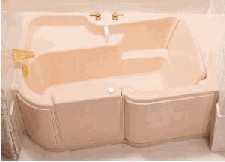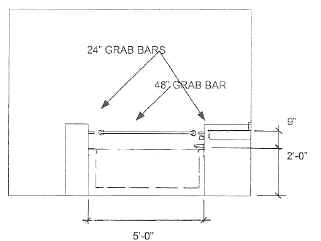Best Practices in the Design of Toileting and Bathing Facilities for Assisted Transfers
Bathtubs (ADAAG 4.20)
ADA Accessibility Guidelines for bathtubs are predicated on the use of a conventional residential bathtub by individuals who independently transfer from a wheelchair directly to a tub seat. However, most eldercare facilities used larger whirlpool baths not conventional residential tubs. Moreover, frail older adults usually have the ability to stand. Therefore they are more likely to transfer into the tub from a standing position regardless of whether they used a wheelchair, walking aid, or no aid at all. Nonetheless, because stepping over the side of the tub as well as lowering down and raising up from the bottom of the tub is a potential safety risk for these individuals, designs were based on caregivers providing assistance and supervision during transfers and bathing. Resident lifts, which are an alternative means of safely transferring an individual into a tub, were generally discouraged, particularly among people with dementia because the experience of being lifted off the ground and lowered into a tub can be a terrifying one for them. However, for more acute populations including a lift was sometimes unavoidable.
4.20.2 Floor Space.
The amount of clear floor space in front of a bathtub required by ADAAG (30"-48" min depth depending on the direction of travel by the length of the tub including a seat at the head of the tub) is based on positioning a wheelchair along side the fixture for a sliding transfer. However, because frail older adults do not perform sliding transfers, clear floor space in eldercare facilities was needed for one or more caregivers to be able to assist with getting in and out of a tub. This not only affected the size of the space, but also where the space was needed.
Therefore, residential tubs that are only accessed from one open side, were typically designed with one end against a wall and 3 open sides from which assistance could be provided. Because wheelchair maneuverability was not an issue, less space was needed on any one side. However, more space was needed overall to accommodate caregiver access from more than one side.
4.20.3 Seat.
As tub seats are intended to keep users from being immersed, the use of tub seats defeated the purpose of providing a whirlpool bath. As a result, tub seats were not provided in conventional whirlpool bathtubs, although they were used in walk-in fixtures (see Alternative Designs below).
4.20.4 Grab Bars.
ADAAG specifications for grab bars vary slightly for bathtubs with in-tub and head of tub seats (the latter having longer bars on the sidewall and no bar on the head wall). Nonetheless, in both conditions, grab bars are located to help individuals get into the tub and then to lower and raise themselves to and from a seated position. Because these positional changes were deemed safety risks for older adults, grab bars that would permit older adults to raise and lower themselves were not included in most bathtub designs (see Alternative Designs below). Rather, in most designs, grab bars were provided adjacent to the tub for temporary support to enable an individual to steady him/herself while a care provider assisted with removal and replacement of clothing. In fact, in instances where local building authorities required bathing fixtures with ADAAG compliant grab bar configurations, roll-in showers were installed instead due to safety concerns, even though the former were readily available from a number of manufacturers.
4.20.5 Controls.
None of the respondents indicated that there were any variations from ADAAG regarding controls.
4.20.6 Shower Unit.
None of the respondents indicated that there were any variations from ADAAG regarding the shower unit.
4.20.7 Bathtub Enclosures.
None of the respondents indicated that there were any variations from ADAAG regarding the enclosure except for the walk-in fixture described below.
Alternative Designs.
One alternative design that was used by OWP&P for less frail, ambulatory individuals was the Kohler "Precedence" bathtub (Figure 14). The tub has a non-institutional appearance, a fold-down seat, and a swinging side entry door with a pressurized seal for ease of access. Similar "walk-in" units, although slightly more institutional in appearance, are made by Arjo ("Freedom" tub) and others. The walk-in capability makes this fixture suitable for either independent or assisted use by individuals with a reasonable level of mobility. In addition, the fixture is also taller than most average bathtubs (24" above the finished floor) which permits immersion in the water even when using its fold-down seat. Whereas the added height and side-entry features address the primary shortcomings of a traditional tub, they also create the two shortcomings of this tub. First, it must be drained to open the door to exit the fixture. As a result, an older individual who can only get out through the door must sit in the tub until it is drained. Second, the tub does not meet ADAAG grab bar provisions. The 24" high sides make it impossible to install the two grab bars on the back wall in the manner prescribed in ADAAG. As a result, in facilities where this fixture (Figure 15) was used, one of the back wall bars was eliminated in order to comply with the distance of 9" from the rim of the tub and 33" –36" distance from the floor to the grab bar. In addition, OWP&P placed a low wall surrounding the tub on one or more sides (usually the foot end and/or the long side opposite the entry). Although this increased the overall space requirement for the bathing room, it provided easier access by a caregiver to assist in the bathing process, enabling them to sit on the wall as well as reach over it.

Figure 14. KohlerPrecedence Bathtub

Figure 15. Bathtub Configuration at Memory Loss Unit at C.C. Young Retirement Community, Dallas, TX (OWP&P)

User Comments/Questions
Add Comment/Question